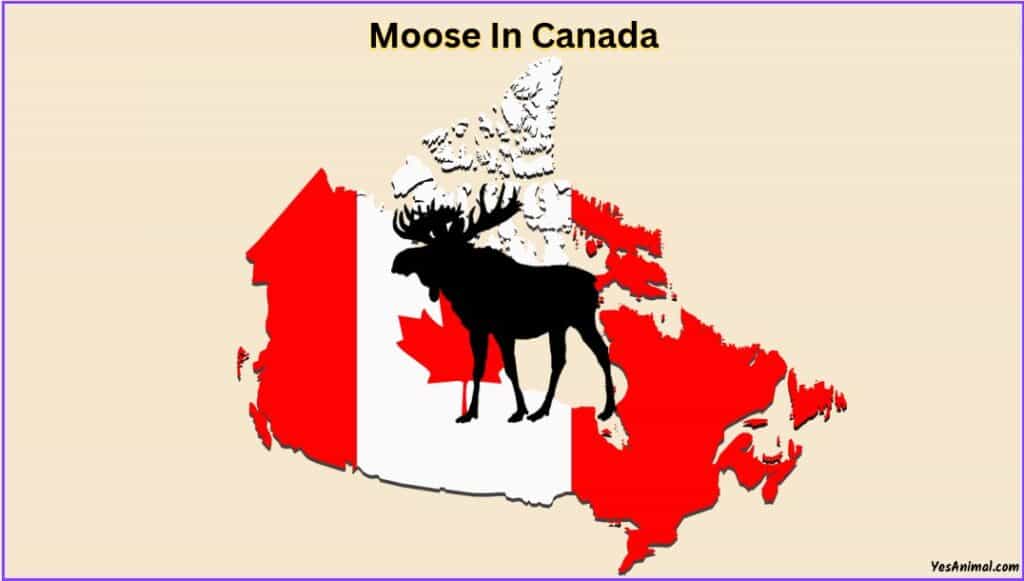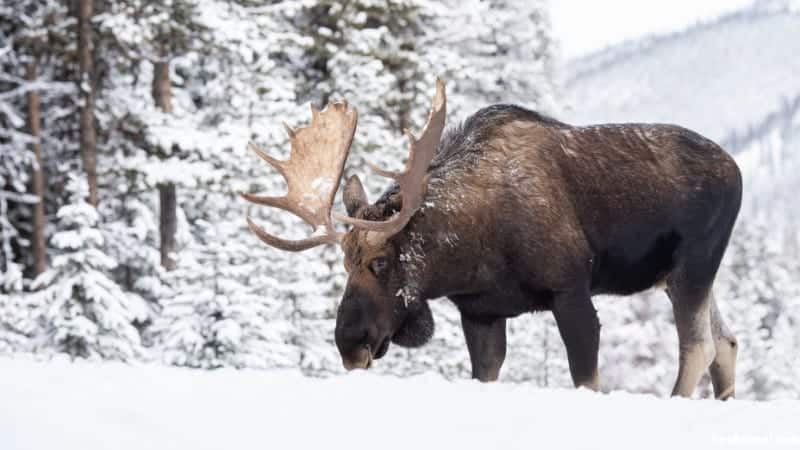Last Updated on September 14, 2023 by Amin Tawar

Most of the time, be it kids or adults, people are strongly attracted to wild creatures, especially the big and scarry ones. Even though these wild creatures are much of a challenge and have specific requirements for survival, residents sacrifice many things to get a chance to own them.
But you needn’t own a carnivore to understand the wild. Instead, support the growth of animals living in difficult circumstances.
One such hidden gem requiring extensive support from humans in this carnivore jungle is the moose. Below I’ve explained everything you need to know about their presence throughout Canada, their physical features, some fun facts about them, and legalities related to their ownership and hunting.
Are There Moose in Canada?
Yes, Moose are found in various regions across Canada. In fact, Moose is the largest living member of the deer family found inhabiting the state. There are actually 4 species of deer found in Canada namely, the Alaska/Yukon moose, the eastern Canada moose, the Shiras moose, and the western Canada moose.
Moose is indeed found in almost all the regions of the state except in the Arctic and Vancouver Island due to unsuitable living conditions for their undulates.
How Many Moose Are Left in Canada?
Moose are native to the North American continent including various parts of Canada. The country does inhabit a stable population of Moose.
But still, they are seriously threatened by loss of habitation and habitat degradation. While it is really difficult to estimate a precise population, it is believed that moose numbers are between 500,000 to 1 million in Canada.
In some provinces like Nova Scotia, even though the moose number is good, the species is still considered endangered. Don’t worry, the Nature Conservancy of Canada has begun a project to monitor and support the migration of moose from nearby New Brunswick to Nova Scotia.
Where To See Moose in Canada?

Moose are tropical animals and prefer regions with forests, lakes, and muskegs. In summer while their habitat and all other places pretty much cover their dietary needs, in winter, Canada moose migrate to other forests with low snow cover to find more food.
In terms of location, these magnificent creatures are found living all throughout the world including Canada. In the country, Moose are found in Québec-Labrador Peninsula, through Nova Scotia and New Brunswick, north to the Arctic Ocean, west to British Columbia, and boreal forest from Newfoundland.
Note that moose were introduced into Newfoundland in about the 1900s. Since then, the moose population in the province has been rising.
Also Check Our Guide On Moose In America
How Big Are Moose in Canada?
Moose are pretty huge and give even tough competition to humans. When standing, their height from the ground until the shoulder is 5 to 6 ½ feet. When lying down, their body length comes to about 7 to 10 feet.
Note that like other wild species, Moose’s size differs from place to place. As per various sightings and surveys, it has been found that the largest individuals are found in the northern states like Alaska and eastern Siberia but the smallest in the southern provinces of the country.
Is Moose the National Animal of Canada?
Moose symbolizes strength, wisdom, and adaptability in Indigenous cultures. That’s why they are constantly a part of various folklore, stories, and literature from the past. Their cultural significance and their role in the wild as a food source for carnivores has made them one of the national animals of Canada.
More like a symbol of Canada by some set of people. The moose shares this title with the beaver which was officially named the national animal in 1975. Few other countries also consider Moose as the national animals like Sweden and Norway.
Is Moose the Largest Animal in Canada?
Oh yes, Reaching the height of humans and length to about double their height, Moose is the largest land animal in Canada. We specify land because the overall largest animal would be the blue whale found in the Pacific and Atlantic Oceans.
Their height, weight and not to forget their antlers, make them a formidable creature and a beautiful sight in the Canadian forests.
Is Moose Eaten in Canada?
Yes, Canada is mostly covered with forests and therefore it makes sense that the country is home to many of the dangerous carnivores.
This, therefore, makes Moose a common prey in the ecosystem. Additionally, this also reiterates the importance of the moose population in the country as without it, most of the carnivores will be unable to consume. Typically, moose are attacked and killed by wolves, bears, and Ravens.
In terms of human consumption, yes, people from the country too consume moose meat and make dishes like moose burgers, steaks, and stews out of it. In fact, residents of the country believe that it is a safe and the healthiest meal. Moose meat along with elk meat is a popular protein source in the country.
Can You Hunt Moose in Canada?
Yes, you can definitely hunt Moose in Canada. In fact, many people hunt and harvest these creatures to obtain good, healthy meat.
Note that, different provinces have different regulations on hunting a moose, and look at it before you plan to do the deed.
The cost to hunt one excluding the gear and travel costs comes to about 3000$ to 5000$. The price is mostly the same in other provinces too.
Also Check Our Guide On moose In Alaska
Can You Ride and Own a Moose in Canada?
Firstly, Moose are wild animals, and their behavior is unpredictable and therefore unreliable. This doesn’t make the suitable for riding or makes them domesticated. They also have a formidable body size and large antlers which could easily injure you if you rode Moose.
Add to this, Moose is protected in Canada, and it is illegal to keep them as a pet or own them without a permit. Best way to look at them and observe them would be to visit a nearby nature reserve, keep your distance, and also respect the creature’s space if you notice it.
Conclusion
And that was everything you need to know about the Moose In Canada. I hope this article answered all your queries.
Thank You For Reading!
Our Source For This Guide